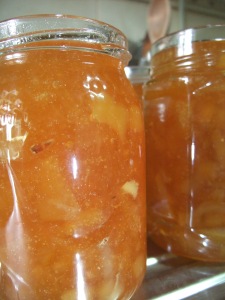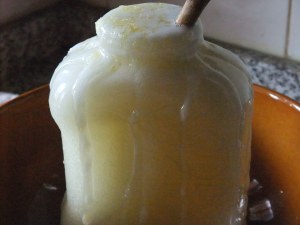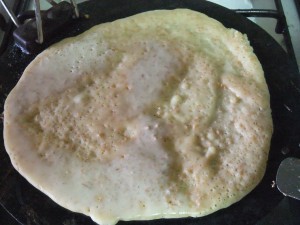The most delicious beer. Thank you so much to our Belgian friends who are currently at the Boom Festival.

Category Archives: In the Kitchen
Simple Rose Face Cooler
As the summer is in full swing here in Portugal, the high temperature compels me to seek out ways of keeping cool. The fan is merely blowing the warm air around in a semblance of refreshment, water is being downed without touching the sides and towels have become capes and bed covers to absorb perspiration. Something I like to keep in the fridge at this time is a spray bottle of Rose Cooler to spritz on my face. It’s so refreshing and, of course, smells delicious.
It’s extremely straightforward to assemble, although you may need to buy some supplies, if you don’t have them in your bathroom cabinet.
 For a 200ml spray bottle, you will need:
For a 200ml spray bottle, you will need:
1 x 5ml teaspoon Rose Water Concentrate 1-39
1/2 tsp. Glycerin
1/2 tsp. Witch Hazel
Top up with spring water.
The glycerin will add a little “slip” quality to the liquid, like you would expect from a commercial blend. The witch hazel is great for refreshing eyes that are tired and puffy from the heat. If you can’t find either, you can make it satisfactorily with just the rose water, but good quality rose concentrate is essential.
The Full of Fitness Food – not!
We were recently discussing my particularity when it comes to flavours of commercial yoghurt. In general, I prefer to eat my homemade, strained, natural yoghurt, but I am tempted by some shop bought ones too. There are some flavours though that I just can’t touch and it stems back to childhood.
I can remember a time before yoghurt was consumed at home. Alongside spaghetti (which either came in yard long, exotic looking, blue packets from Italy, or out of tins, smothered in sweet, luminous, orange sauce), yoghurt was not something familiar to my traditional, Cornish household. I was 1 year old when Captain Birds Eye introduced his first fish finger and 8 when sickly Ski yoghurt became available, along with the jingle “Ski, the Full of Fitness Food”. The following is from a BBC article on the subject:
“Just 60 years ago, the yoghurt market did not exist. It was only really found in health shops. But in 1963, Swiss-invented Ski was launched in the UK. With added sugar and real fruit it was an instant hit and launched a yoghurt revolution on our supermarket shelves.”
New flavours kept arriving and two stick in my mind, as they stuck in my throat; orange and hazelnut. The first was particularly synthetic and artificial and the later smelt to me of puke. To this day, I can’t eat citrus or nut flavoured yoghurts, unless I’ve flavoured them myself.
Fair Exchange is No Robbery
Here in central Portugal, as in many rural areas of the world, it is customary for neighbours to be, well, neighbourly. Since we moved into this house in September, our neighbours have regulary knocked on our gate with generous gifts; buckets of potatoes, lettuce the size of dinner plates, bread hot from the oven, olive oil, homemade wine and firewater, that sort of thing.
Sometimes I feel I have to offer to pay, even though I know this gesture will be met with a disgusted look and a dismissive wave of the hand. Occasionally, I have something I can offer in return, although this is tricky. This is because we grow less and eat differently, hanging on to our north European diet as much as possible. Not eating meat makes us strange. I make my own natural yoghurt, which I tried sharing but didn’t seem to enthuse them. Home made chutney is appreciated by fellow ex-pats but, in my experience, Portuguese don’t know what to do with it. My style of cake baking is sweeter and lighter than they are used to. A general observation here is that Portuguese are not very adventurous when it comes to food.
On Saturday I was baking sourdough bread when my neighbour called me out with a hot loaf of her bread. So an exchange was possible. It will be interesting to discover if they have any feedback. I doubt they have tasted wholemeal sourdough before – hers’ is traditional white bread. I have to say, bread flour here is not very good quality and you have to seek out a decent wholemeal flour.
A Marmalade for Sore Throats
Our friends in Ribatejo have an abundance of lemons. They have maybe 6 or 8 mature lemon trees, all dripping with large, juicy lemons. We’ve been there twice in the last month and on both occasions came back with a car boot full of fruit. If they lived closer they could supply us and our neighbourhood for the whole year.
So far I have made; Lemon Pickle, Lemon, Plum and Courgette Chutney, Lemon Meringue Pie, Lemon Cheesecake, Salted Lemons, Lemon Syrup and this, Lemon and Ginger Marmalade. I still have lemons filling my fridge’s salad drawer and a box full besides.
This marmalade turned out to have a fantastic set. I may be the appointed Queen of Chutney but I’ve made some dodgy marmalade in the past! It’s often still runny because I don’t like to boil away the fruity flavour, or occasionally it’s been like toffee and inedible, so I was really pleased that this set like a dream.
I added 100 gram packet of crystallised ginger and 1 teaspoon of powdered ginger to the recipe, which used 1.5 lbs of lemons. The ginger taste is strong and I think this will be very popular in the winter. In fact, I can imagine that a spoonful of this will make a very good remedy for a sore throat and that, dissolved in boiling water, it will ward off winter chills. I’m really glad we have a toaster again (but that’s another story!).
Eeek – It’s Alive!
This should have been Lemon Syrup but wow, when I went to stir the mix, look what happened! I’ve used this method from Mamta’s Kitchen before, and it was a complete success. I have no idea why this time the lemons have fermented, other than it is very hot. Mamta is from India though and India is much hotter than here in Portugal, and the recipe does not suggest heat could cause fermentation. It surprised me somewhat, as I have never heard of lemon wine, but that is what I am creating. I’m just going to run with it and see how it turns out. It may turn out as a happy accident.
Late Breakfast
One thing I always have in the fridge is a load of whey that needs using up. This is because I make on average 2-3 litres of yogurt most weeks. Whey is the bi-product from straining it (not essential but it makes the yogurt thick and yummy, like Greek style). The dog gets most of it. as it is high in protein and good for making her biscuits less dry. Then I regularly use it to make a quick chapati or roti style flat-bread – a handy lunch when we’ve overlooked the empty bread bin. I like to make scones with it too. My recipe for Whey Scones comes from Cindy’s Snowflakes, here.
Today I fancied pancakes for brunch and very good they were too. It’s the first time out for this recipe, which came from King Arthur Flour, here. Using wholemeal flour, omitting the sweetener and using the minimum oil (I used olive oil because it’s what I have), kept them healthy. Also, cooking them on a cast iron griddle, without oil, as the recipe recommends, increased the healthy aspect. I love to use my late Mother’s griddle. It must be 60 years old and languished unused for many years, but now it is back in regular service – it would have made her very happy to see me get practical use from it.



